Australian Economic Analysis
VerifiedAdded on 2023/02/06
|9
|1937
|95
AI Summary
This article provides an analysis of the Australian economy, focusing on key indicators such as GDP, inflation, and unemployment. It explores the impact of the Covid-19 pandemic on the economy and discusses the future outlook for Australia's economic growth.
Contribute Materials
Your contribution can guide someone’s learning journey. Share your
documents today.
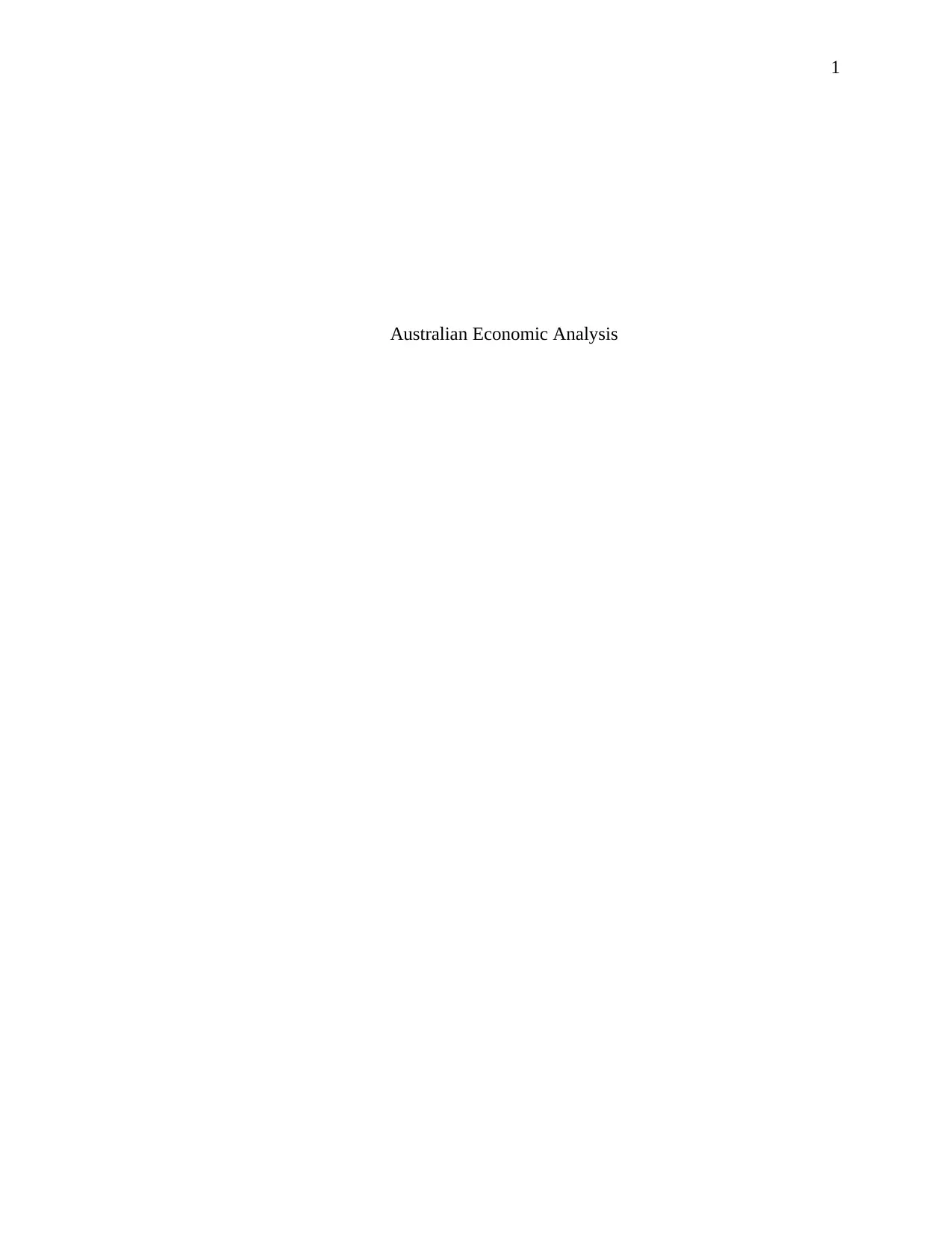
1
Australian Economic Analysis
Australian Economic Analysis
Secure Best Marks with AI Grader
Need help grading? Try our AI Grader for instant feedback on your assignments.
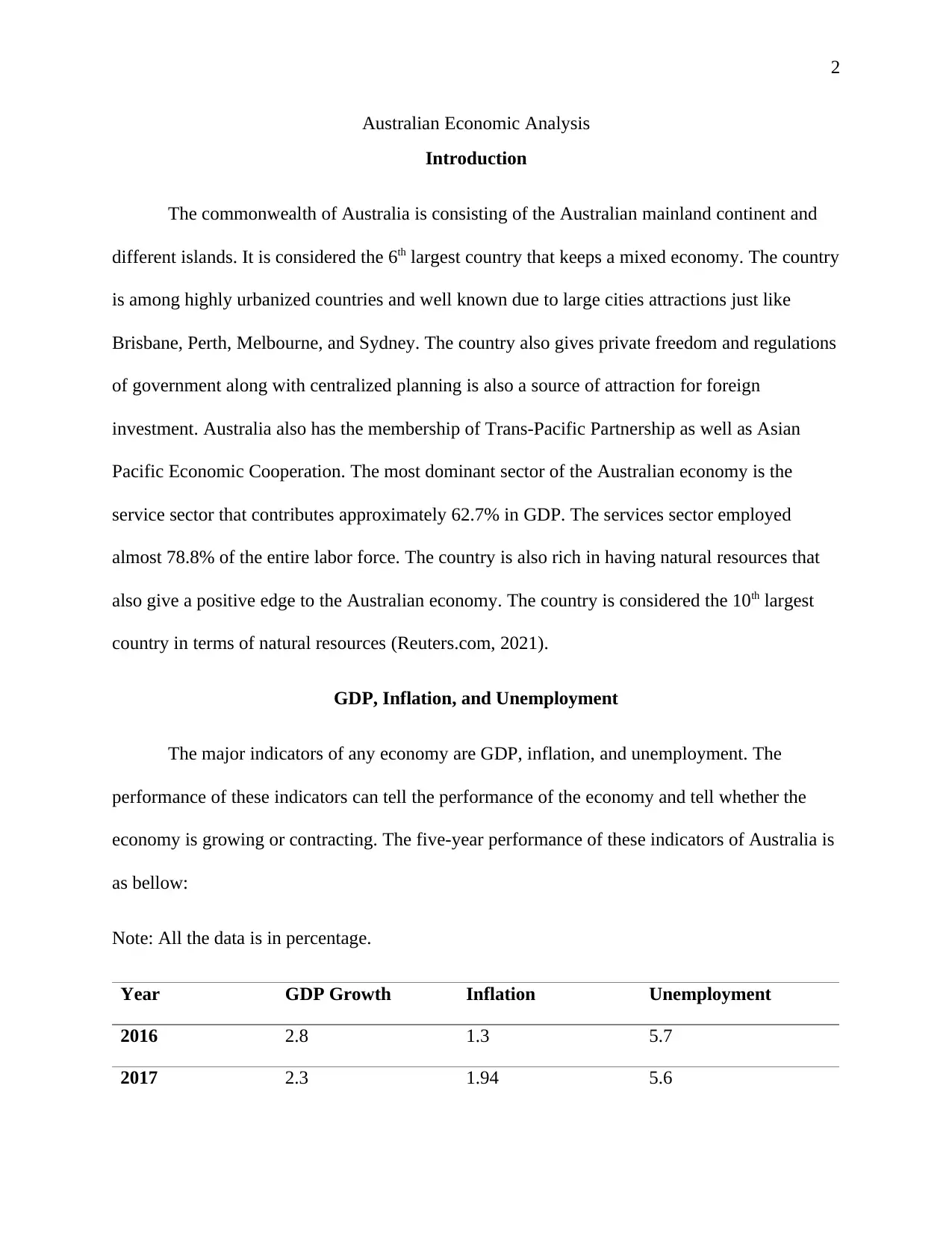
2
Australian Economic Analysis
Introduction
The commonwealth of Australia is consisting of the Australian mainland continent and
different islands. It is considered the 6th largest country that keeps a mixed economy. The country
is among highly urbanized countries and well known due to large cities attractions just like
Brisbane, Perth, Melbourne, and Sydney. The country also gives private freedom and regulations
of government along with centralized planning is also a source of attraction for foreign
investment. Australia also has the membership of Trans-Pacific Partnership as well as Asian
Pacific Economic Cooperation. The most dominant sector of the Australian economy is the
service sector that contributes approximately 62.7% in GDP. The services sector employed
almost 78.8% of the entire labor force. The country is also rich in having natural resources that
also give a positive edge to the Australian economy. The country is considered the 10th largest
country in terms of natural resources (Reuters.com, 2021).
GDP, Inflation, and Unemployment
The major indicators of any economy are GDP, inflation, and unemployment. The
performance of these indicators can tell the performance of the economy and tell whether the
economy is growing or contracting. The five-year performance of these indicators of Australia is
as bellow:
Note: All the data is in percentage.
Year GDP Growth Inflation Unemployment
2016 2.8 1.3 5.7
2017 2.3 1.94 5.6
Australian Economic Analysis
Introduction
The commonwealth of Australia is consisting of the Australian mainland continent and
different islands. It is considered the 6th largest country that keeps a mixed economy. The country
is among highly urbanized countries and well known due to large cities attractions just like
Brisbane, Perth, Melbourne, and Sydney. The country also gives private freedom and regulations
of government along with centralized planning is also a source of attraction for foreign
investment. Australia also has the membership of Trans-Pacific Partnership as well as Asian
Pacific Economic Cooperation. The most dominant sector of the Australian economy is the
service sector that contributes approximately 62.7% in GDP. The services sector employed
almost 78.8% of the entire labor force. The country is also rich in having natural resources that
also give a positive edge to the Australian economy. The country is considered the 10th largest
country in terms of natural resources (Reuters.com, 2021).
GDP, Inflation, and Unemployment
The major indicators of any economy are GDP, inflation, and unemployment. The
performance of these indicators can tell the performance of the economy and tell whether the
economy is growing or contracting. The five-year performance of these indicators of Australia is
as bellow:
Note: All the data is in percentage.
Year GDP Growth Inflation Unemployment
2016 2.8 1.3 5.7
2017 2.3 1.94 5.6
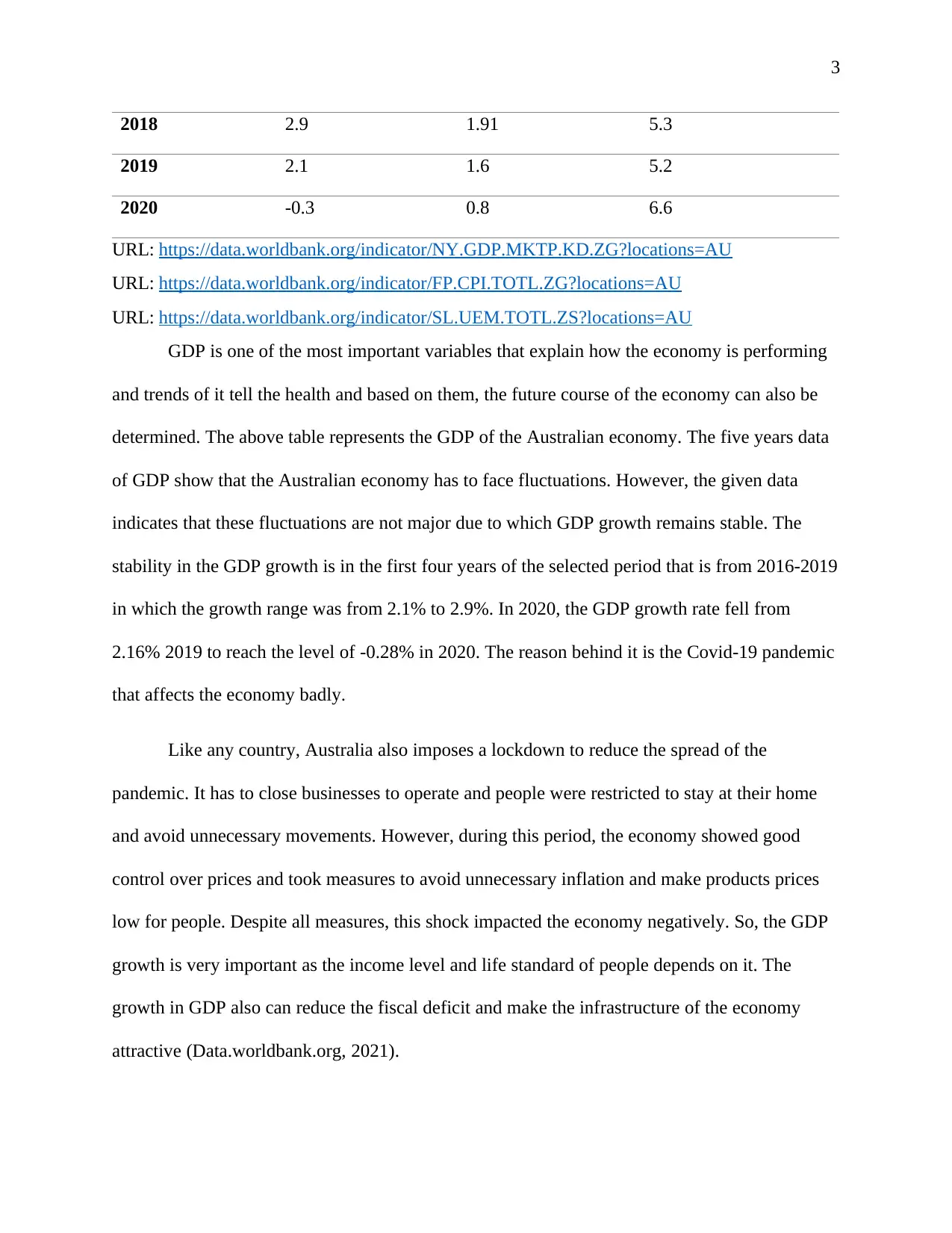
3
2018 2.9 1.91 5.3
2019 2.1 1.6 5.2
2020 -0.3 0.8 6.6
URL: https://data.worldbank.org/indicator/NY.GDP.MKTP.KD.ZG?locations=AU
URL: https://data.worldbank.org/indicator/FP.CPI.TOTL.ZG?locations=AU
URL: https://data.worldbank.org/indicator/SL.UEM.TOTL.ZS?locations=AU
GDP is one of the most important variables that explain how the economy is performing
and trends of it tell the health and based on them, the future course of the economy can also be
determined. The above table represents the GDP of the Australian economy. The five years data
of GDP show that the Australian economy has to face fluctuations. However, the given data
indicates that these fluctuations are not major due to which GDP growth remains stable. The
stability in the GDP growth is in the first four years of the selected period that is from 2016-2019
in which the growth range was from 2.1% to 2.9%. In 2020, the GDP growth rate fell from
2.16% 2019 to reach the level of -0.28% in 2020. The reason behind it is the Covid-19 pandemic
that affects the economy badly.
Like any country, Australia also imposes a lockdown to reduce the spread of the
pandemic. It has to close businesses to operate and people were restricted to stay at their home
and avoid unnecessary movements. However, during this period, the economy showed good
control over prices and took measures to avoid unnecessary inflation and make products prices
low for people. Despite all measures, this shock impacted the economy negatively. So, the GDP
growth is very important as the income level and life standard of people depends on it. The
growth in GDP also can reduce the fiscal deficit and make the infrastructure of the economy
attractive (Data.worldbank.org, 2021).
2018 2.9 1.91 5.3
2019 2.1 1.6 5.2
2020 -0.3 0.8 6.6
URL: https://data.worldbank.org/indicator/NY.GDP.MKTP.KD.ZG?locations=AU
URL: https://data.worldbank.org/indicator/FP.CPI.TOTL.ZG?locations=AU
URL: https://data.worldbank.org/indicator/SL.UEM.TOTL.ZS?locations=AU
GDP is one of the most important variables that explain how the economy is performing
and trends of it tell the health and based on them, the future course of the economy can also be
determined. The above table represents the GDP of the Australian economy. The five years data
of GDP show that the Australian economy has to face fluctuations. However, the given data
indicates that these fluctuations are not major due to which GDP growth remains stable. The
stability in the GDP growth is in the first four years of the selected period that is from 2016-2019
in which the growth range was from 2.1% to 2.9%. In 2020, the GDP growth rate fell from
2.16% 2019 to reach the level of -0.28% in 2020. The reason behind it is the Covid-19 pandemic
that affects the economy badly.
Like any country, Australia also imposes a lockdown to reduce the spread of the
pandemic. It has to close businesses to operate and people were restricted to stay at their home
and avoid unnecessary movements. However, during this period, the economy showed good
control over prices and took measures to avoid unnecessary inflation and make products prices
low for people. Despite all measures, this shock impacted the economy negatively. So, the GDP
growth is very important as the income level and life standard of people depends on it. The
growth in GDP also can reduce the fiscal deficit and make the infrastructure of the economy
attractive (Data.worldbank.org, 2021).
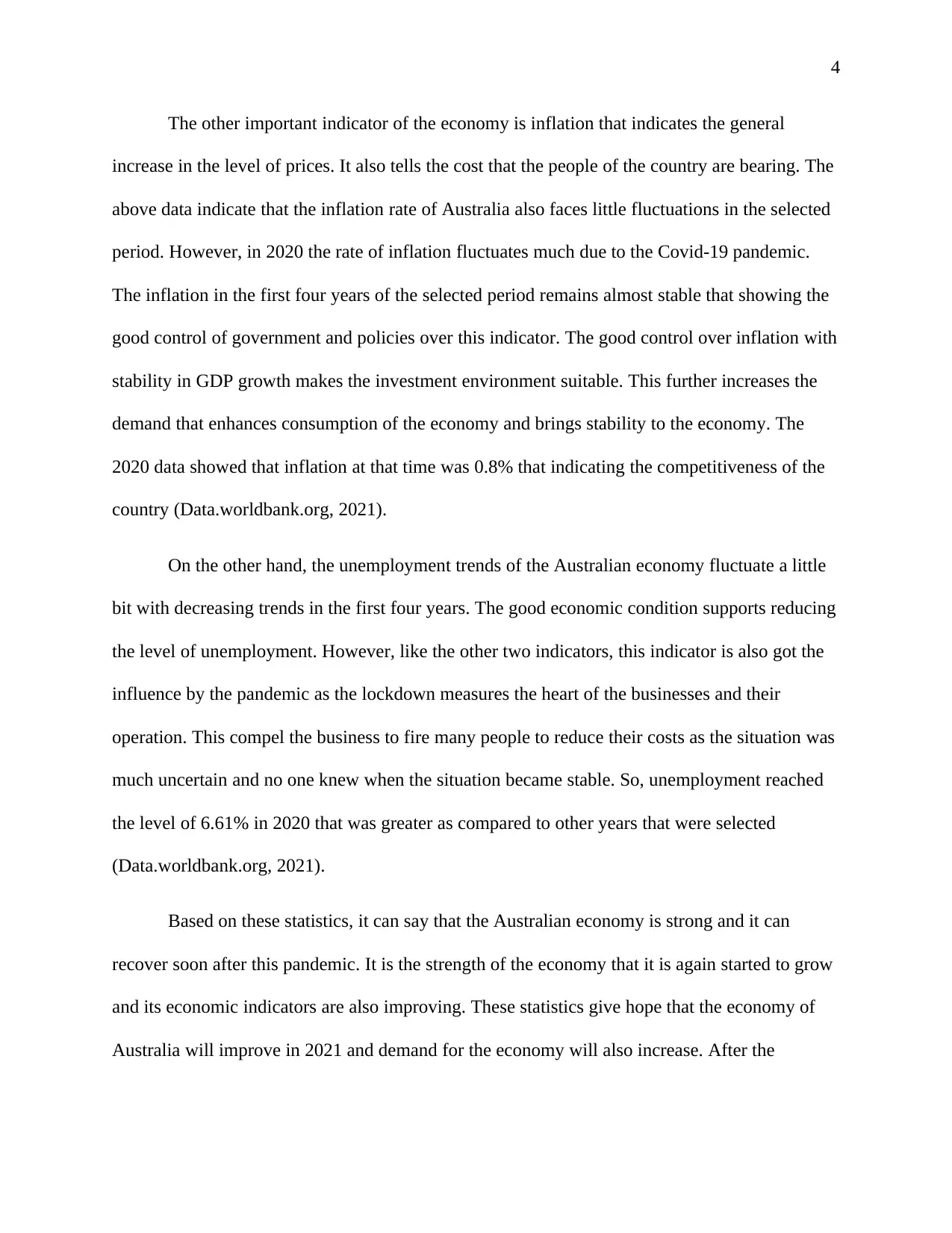
4
The other important indicator of the economy is inflation that indicates the general
increase in the level of prices. It also tells the cost that the people of the country are bearing. The
above data indicate that the inflation rate of Australia also faces little fluctuations in the selected
period. However, in 2020 the rate of inflation fluctuates much due to the Covid-19 pandemic.
The inflation in the first four years of the selected period remains almost stable that showing the
good control of government and policies over this indicator. The good control over inflation with
stability in GDP growth makes the investment environment suitable. This further increases the
demand that enhances consumption of the economy and brings stability to the economy. The
2020 data showed that inflation at that time was 0.8% that indicating the competitiveness of the
country (Data.worldbank.org, 2021).
On the other hand, the unemployment trends of the Australian economy fluctuate a little
bit with decreasing trends in the first four years. The good economic condition supports reducing
the level of unemployment. However, like the other two indicators, this indicator is also got the
influence by the pandemic as the lockdown measures the heart of the businesses and their
operation. This compel the business to fire many people to reduce their costs as the situation was
much uncertain and no one knew when the situation became stable. So, unemployment reached
the level of 6.61% in 2020 that was greater as compared to other years that were selected
(Data.worldbank.org, 2021).
Based on these statistics, it can say that the Australian economy is strong and it can
recover soon after this pandemic. It is the strength of the economy that it is again started to grow
and its economic indicators are also improving. These statistics give hope that the economy of
Australia will improve in 2021 and demand for the economy will also increase. After the
The other important indicator of the economy is inflation that indicates the general
increase in the level of prices. It also tells the cost that the people of the country are bearing. The
above data indicate that the inflation rate of Australia also faces little fluctuations in the selected
period. However, in 2020 the rate of inflation fluctuates much due to the Covid-19 pandemic.
The inflation in the first four years of the selected period remains almost stable that showing the
good control of government and policies over this indicator. The good control over inflation with
stability in GDP growth makes the investment environment suitable. This further increases the
demand that enhances consumption of the economy and brings stability to the economy. The
2020 data showed that inflation at that time was 0.8% that indicating the competitiveness of the
country (Data.worldbank.org, 2021).
On the other hand, the unemployment trends of the Australian economy fluctuate a little
bit with decreasing trends in the first four years. The good economic condition supports reducing
the level of unemployment. However, like the other two indicators, this indicator is also got the
influence by the pandemic as the lockdown measures the heart of the businesses and their
operation. This compel the business to fire many people to reduce their costs as the situation was
much uncertain and no one knew when the situation became stable. So, unemployment reached
the level of 6.61% in 2020 that was greater as compared to other years that were selected
(Data.worldbank.org, 2021).
Based on these statistics, it can say that the Australian economy is strong and it can
recover soon after this pandemic. It is the strength of the economy that it is again started to grow
and its economic indicators are also improving. These statistics give hope that the economy of
Australia will improve in 2021 and demand for the economy will also increase. After the
Secure Best Marks with AI Grader
Need help grading? Try our AI Grader for instant feedback on your assignments.
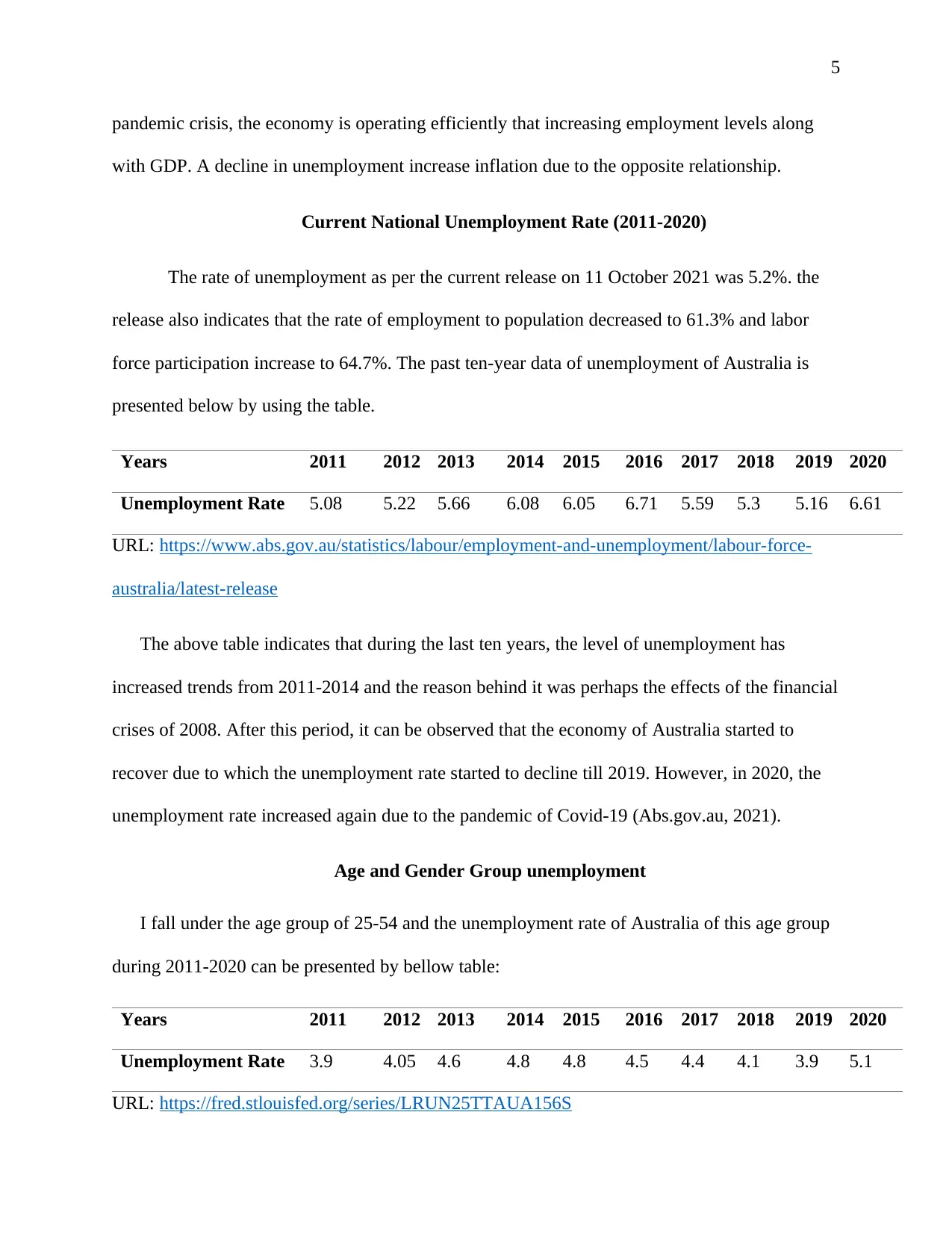
5
pandemic crisis, the economy is operating efficiently that increasing employment levels along
with GDP. A decline in unemployment increase inflation due to the opposite relationship.
Current National Unemployment Rate (2011-2020)
The rate of unemployment as per the current release on 11 October 2021 was 5.2%. the
release also indicates that the rate of employment to population decreased to 61.3% and labor
force participation increase to 64.7%. The past ten-year data of unemployment of Australia is
presented below by using the table.
Years 2011 2012 2013 2014 2015 2016 2017 2018 2019 2020
Unemployment Rate 5.08 5.22 5.66 6.08 6.05 6.71 5.59 5.3 5.16 6.61
URL: https://www.abs.gov.au/statistics/labour/employment-and-unemployment/labour-force-
australia/latest-release
The above table indicates that during the last ten years, the level of unemployment has
increased trends from 2011-2014 and the reason behind it was perhaps the effects of the financial
crises of 2008. After this period, it can be observed that the economy of Australia started to
recover due to which the unemployment rate started to decline till 2019. However, in 2020, the
unemployment rate increased again due to the pandemic of Covid-19 (Abs.gov.au, 2021).
Age and Gender Group unemployment
I fall under the age group of 25-54 and the unemployment rate of Australia of this age group
during 2011-2020 can be presented by bellow table:
Years 2011 2012 2013 2014 2015 2016 2017 2018 2019 2020
Unemployment Rate 3.9 4.05 4.6 4.8 4.8 4.5 4.4 4.1 3.9 5.1
URL: https://fred.stlouisfed.org/series/LRUN25TTAUA156S
pandemic crisis, the economy is operating efficiently that increasing employment levels along
with GDP. A decline in unemployment increase inflation due to the opposite relationship.
Current National Unemployment Rate (2011-2020)
The rate of unemployment as per the current release on 11 October 2021 was 5.2%. the
release also indicates that the rate of employment to population decreased to 61.3% and labor
force participation increase to 64.7%. The past ten-year data of unemployment of Australia is
presented below by using the table.
Years 2011 2012 2013 2014 2015 2016 2017 2018 2019 2020
Unemployment Rate 5.08 5.22 5.66 6.08 6.05 6.71 5.59 5.3 5.16 6.61
URL: https://www.abs.gov.au/statistics/labour/employment-and-unemployment/labour-force-
australia/latest-release
The above table indicates that during the last ten years, the level of unemployment has
increased trends from 2011-2014 and the reason behind it was perhaps the effects of the financial
crises of 2008. After this period, it can be observed that the economy of Australia started to
recover due to which the unemployment rate started to decline till 2019. However, in 2020, the
unemployment rate increased again due to the pandemic of Covid-19 (Abs.gov.au, 2021).
Age and Gender Group unemployment
I fall under the age group of 25-54 and the unemployment rate of Australia of this age group
during 2011-2020 can be presented by bellow table:
Years 2011 2012 2013 2014 2015 2016 2017 2018 2019 2020
Unemployment Rate 3.9 4.05 4.6 4.8 4.8 4.5 4.4 4.1 3.9 5.1
URL: https://fred.stlouisfed.org/series/LRUN25TTAUA156S
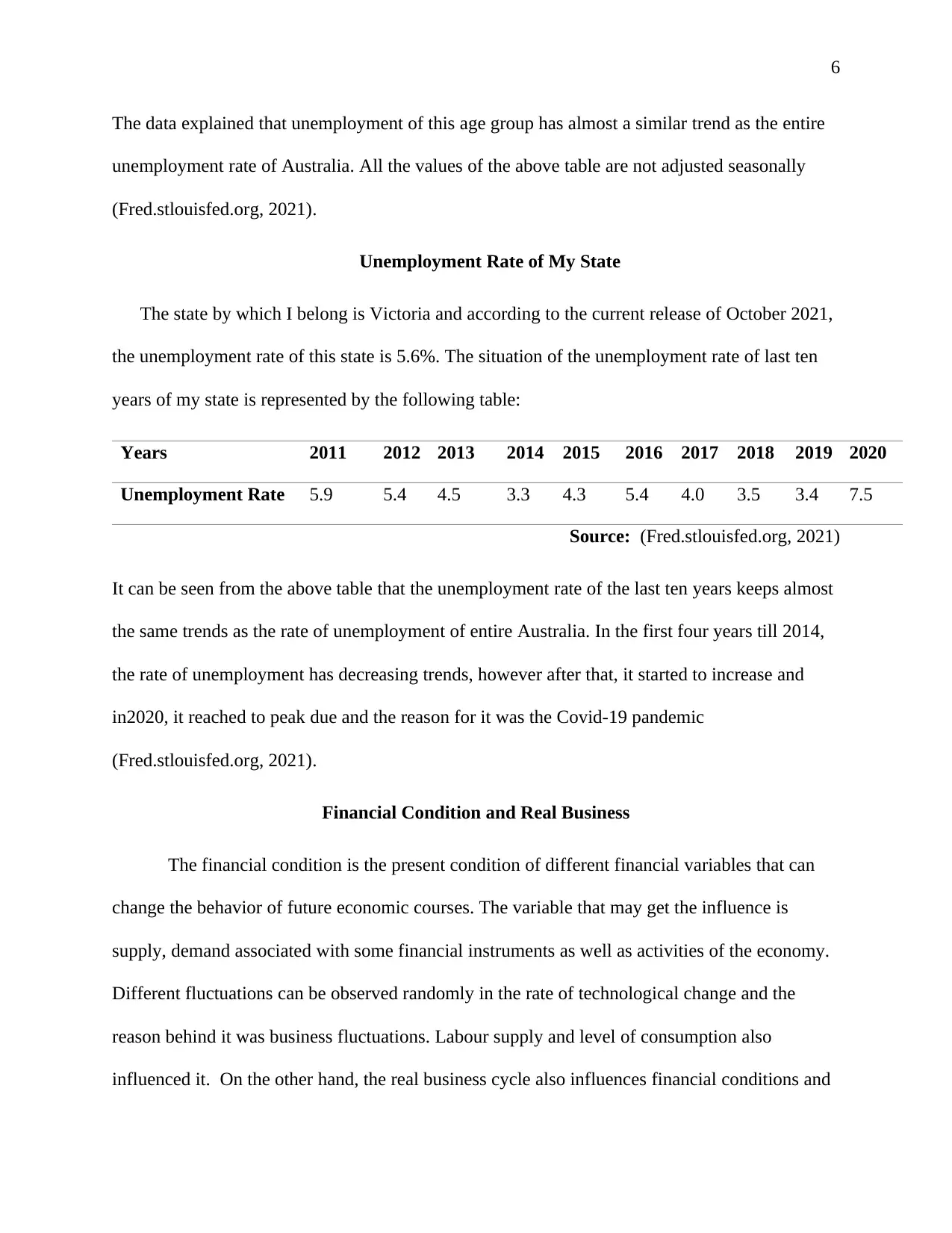
6
The data explained that unemployment of this age group has almost a similar trend as the entire
unemployment rate of Australia. All the values of the above table are not adjusted seasonally
(Fred.stlouisfed.org, 2021).
Unemployment Rate of My State
The state by which I belong is Victoria and according to the current release of October 2021,
the unemployment rate of this state is 5.6%. The situation of the unemployment rate of last ten
years of my state is represented by the following table:
Years 2011 2012 2013 2014 2015 2016 2017 2018 2019 2020
Unemployment Rate 5.9 5.4 4.5 3.3 4.3 5.4 4.0 3.5 3.4 7.5
Source: (Fred.stlouisfed.org, 2021)
It can be seen from the above table that the unemployment rate of the last ten years keeps almost
the same trends as the rate of unemployment of entire Australia. In the first four years till 2014,
the rate of unemployment has decreasing trends, however after that, it started to increase and
in2020, it reached to peak due and the reason for it was the Covid-19 pandemic
(Fred.stlouisfed.org, 2021).
Financial Condition and Real Business
The financial condition is the present condition of different financial variables that can
change the behavior of future economic courses. The variable that may get the influence is
supply, demand associated with some financial instruments as well as activities of the economy.
Different fluctuations can be observed randomly in the rate of technological change and the
reason behind it was business fluctuations. Labour supply and level of consumption also
influenced it. On the other hand, the real business cycle also influences financial conditions and
The data explained that unemployment of this age group has almost a similar trend as the entire
unemployment rate of Australia. All the values of the above table are not adjusted seasonally
(Fred.stlouisfed.org, 2021).
Unemployment Rate of My State
The state by which I belong is Victoria and according to the current release of October 2021,
the unemployment rate of this state is 5.6%. The situation of the unemployment rate of last ten
years of my state is represented by the following table:
Years 2011 2012 2013 2014 2015 2016 2017 2018 2019 2020
Unemployment Rate 5.9 5.4 4.5 3.3 4.3 5.4 4.0 3.5 3.4 7.5
Source: (Fred.stlouisfed.org, 2021)
It can be seen from the above table that the unemployment rate of the last ten years keeps almost
the same trends as the rate of unemployment of entire Australia. In the first four years till 2014,
the rate of unemployment has decreasing trends, however after that, it started to increase and
in2020, it reached to peak due and the reason for it was the Covid-19 pandemic
(Fred.stlouisfed.org, 2021).
Financial Condition and Real Business
The financial condition is the present condition of different financial variables that can
change the behavior of future economic courses. The variable that may get the influence is
supply, demand associated with some financial instruments as well as activities of the economy.
Different fluctuations can be observed randomly in the rate of technological change and the
reason behind it was business fluctuations. Labour supply and level of consumption also
influenced it. On the other hand, the real business cycle also influences financial conditions and
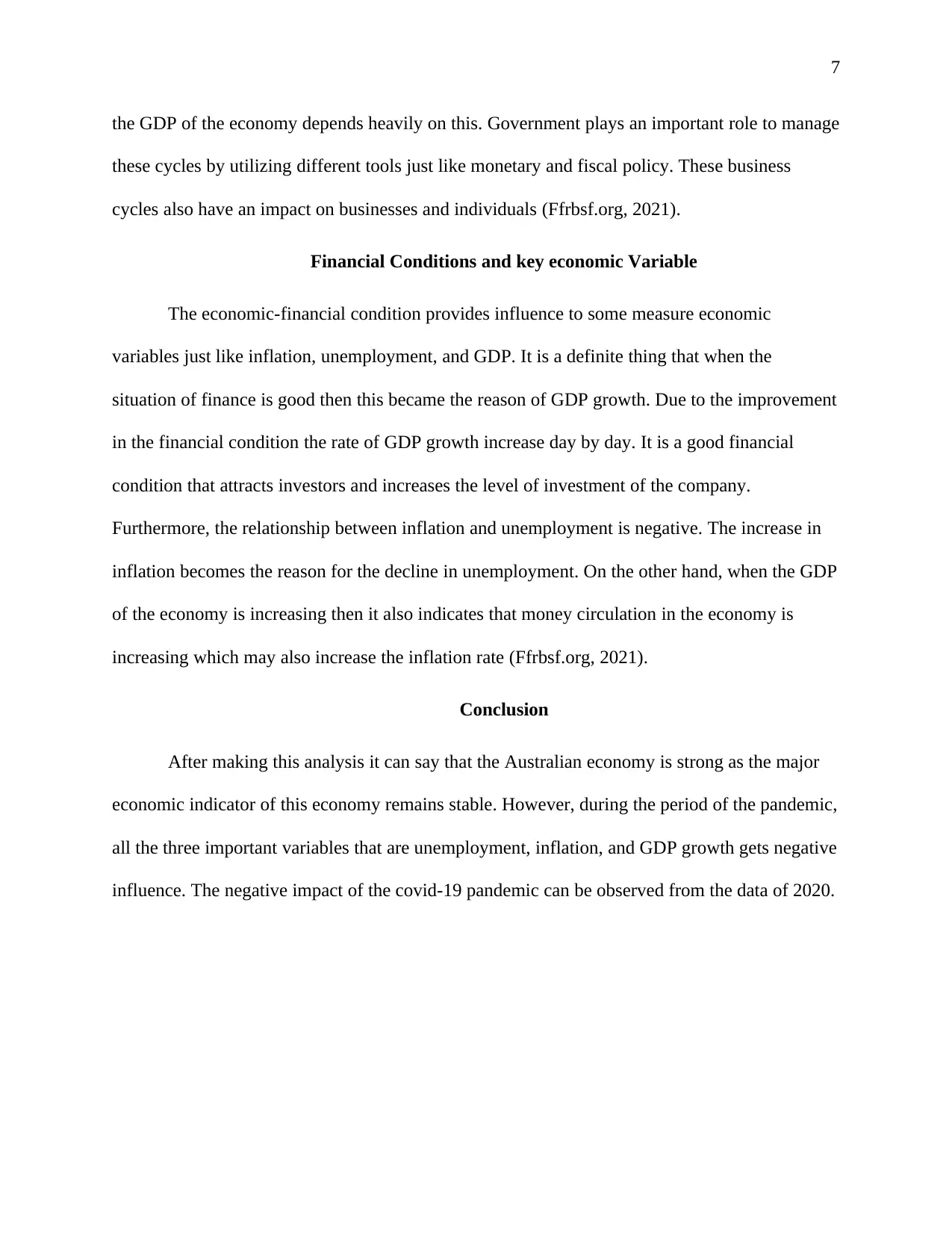
7
the GDP of the economy depends heavily on this. Government plays an important role to manage
these cycles by utilizing different tools just like monetary and fiscal policy. These business
cycles also have an impact on businesses and individuals (Ffrbsf.org, 2021).
Financial Conditions and key economic Variable
The economic-financial condition provides influence to some measure economic
variables just like inflation, unemployment, and GDP. It is a definite thing that when the
situation of finance is good then this became the reason of GDP growth. Due to the improvement
in the financial condition the rate of GDP growth increase day by day. It is a good financial
condition that attracts investors and increases the level of investment of the company.
Furthermore, the relationship between inflation and unemployment is negative. The increase in
inflation becomes the reason for the decline in unemployment. On the other hand, when the GDP
of the economy is increasing then it also indicates that money circulation in the economy is
increasing which may also increase the inflation rate (Ffrbsf.org, 2021).
Conclusion
After making this analysis it can say that the Australian economy is strong as the major
economic indicator of this economy remains stable. However, during the period of the pandemic,
all the three important variables that are unemployment, inflation, and GDP growth gets negative
influence. The negative impact of the covid-19 pandemic can be observed from the data of 2020.
the GDP of the economy depends heavily on this. Government plays an important role to manage
these cycles by utilizing different tools just like monetary and fiscal policy. These business
cycles also have an impact on businesses and individuals (Ffrbsf.org, 2021).
Financial Conditions and key economic Variable
The economic-financial condition provides influence to some measure economic
variables just like inflation, unemployment, and GDP. It is a definite thing that when the
situation of finance is good then this became the reason of GDP growth. Due to the improvement
in the financial condition the rate of GDP growth increase day by day. It is a good financial
condition that attracts investors and increases the level of investment of the company.
Furthermore, the relationship between inflation and unemployment is negative. The increase in
inflation becomes the reason for the decline in unemployment. On the other hand, when the GDP
of the economy is increasing then it also indicates that money circulation in the economy is
increasing which may also increase the inflation rate (Ffrbsf.org, 2021).
Conclusion
After making this analysis it can say that the Australian economy is strong as the major
economic indicator of this economy remains stable. However, during the period of the pandemic,
all the three important variables that are unemployment, inflation, and GDP growth gets negative
influence. The negative impact of the covid-19 pandemic can be observed from the data of 2020.
Paraphrase This Document
Need a fresh take? Get an instant paraphrase of this document with our AI Paraphraser
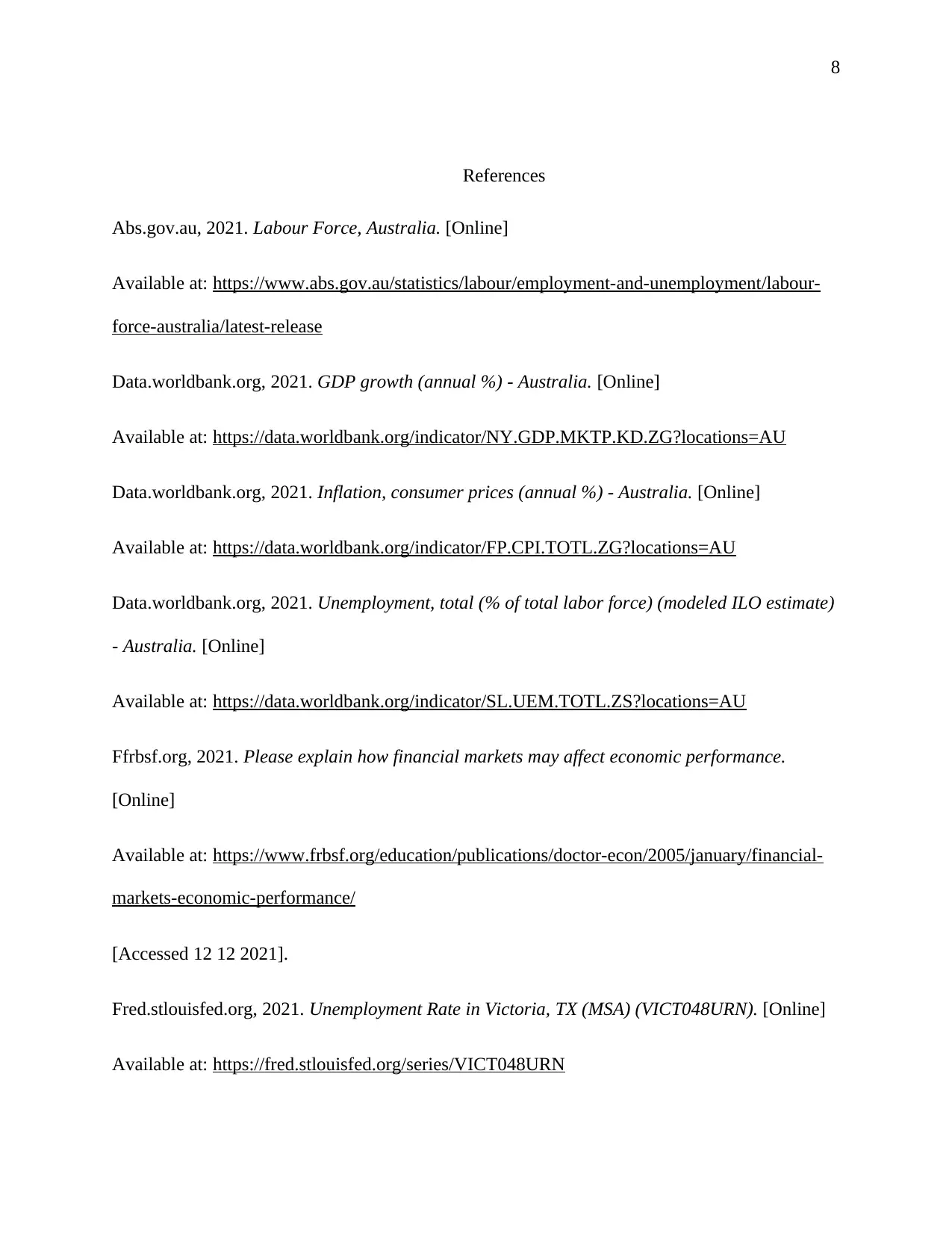
8
References
Abs.gov.au, 2021. Labour Force, Australia. [Online]
Available at: https://www.abs.gov.au/statistics/labour/employment-and-unemployment/labour-
force-australia/latest-release
Data.worldbank.org, 2021. GDP growth (annual %) - Australia. [Online]
Available at: https://data.worldbank.org/indicator/NY.GDP.MKTP.KD.ZG?locations=AU
Data.worldbank.org, 2021. Inflation, consumer prices (annual %) - Australia. [Online]
Available at: https://data.worldbank.org/indicator/FP.CPI.TOTL.ZG?locations=AU
Data.worldbank.org, 2021. Unemployment, total (% of total labor force) (modeled ILO estimate)
- Australia. [Online]
Available at: https://data.worldbank.org/indicator/SL.UEM.TOTL.ZS?locations=AU
Ffrbsf.org, 2021. Please explain how financial markets may affect economic performance.
[Online]
Available at: https://www.frbsf.org/education/publications/doctor-econ/2005/january/financial-
markets-economic-performance/
[Accessed 12 12 2021].
Fred.stlouisfed.org, 2021. Unemployment Rate in Victoria, TX (MSA) (VICT048URN). [Online]
Available at: https://fred.stlouisfed.org/series/VICT048URN
References
Abs.gov.au, 2021. Labour Force, Australia. [Online]
Available at: https://www.abs.gov.au/statistics/labour/employment-and-unemployment/labour-
force-australia/latest-release
Data.worldbank.org, 2021. GDP growth (annual %) - Australia. [Online]
Available at: https://data.worldbank.org/indicator/NY.GDP.MKTP.KD.ZG?locations=AU
Data.worldbank.org, 2021. Inflation, consumer prices (annual %) - Australia. [Online]
Available at: https://data.worldbank.org/indicator/FP.CPI.TOTL.ZG?locations=AU
Data.worldbank.org, 2021. Unemployment, total (% of total labor force) (modeled ILO estimate)
- Australia. [Online]
Available at: https://data.worldbank.org/indicator/SL.UEM.TOTL.ZS?locations=AU
Ffrbsf.org, 2021. Please explain how financial markets may affect economic performance.
[Online]
Available at: https://www.frbsf.org/education/publications/doctor-econ/2005/january/financial-
markets-economic-performance/
[Accessed 12 12 2021].
Fred.stlouisfed.org, 2021. Unemployment Rate in Victoria, TX (MSA) (VICT048URN). [Online]
Available at: https://fred.stlouisfed.org/series/VICT048URN
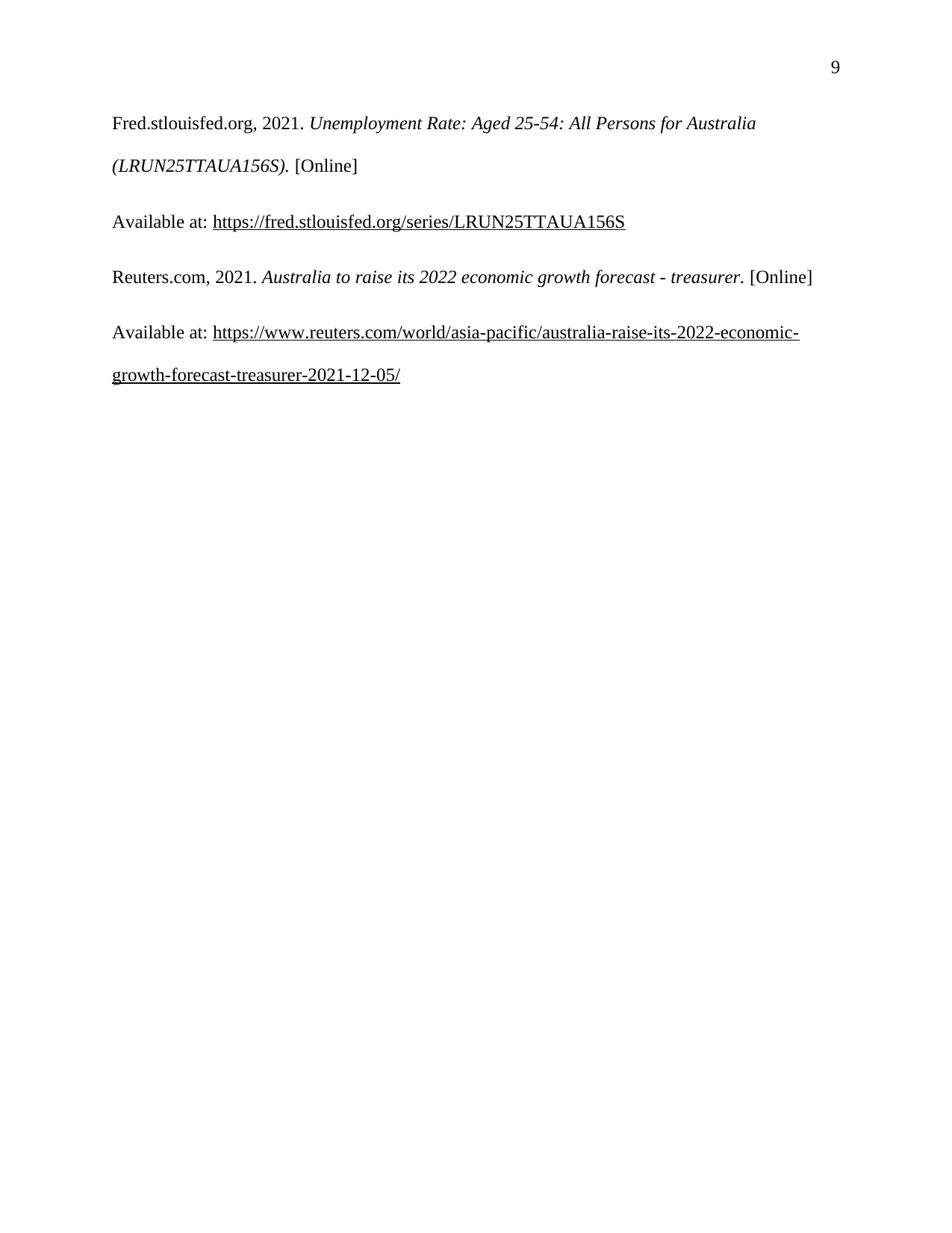
9
Fred.stlouisfed.org, 2021. Unemployment Rate: Aged 25-54: All Persons for Australia
(LRUN25TTAUA156S). [Online]
Available at: https://fred.stlouisfed.org/series/LRUN25TTAUA156S
Reuters.com, 2021. Australia to raise its 2022 economic growth forecast - treasurer. [Online]
Available at: https://www.reuters.com/world/asia-pacific/australia-raise-its-2022-economic-
growth-forecast-treasurer-2021-12-05/
Fred.stlouisfed.org, 2021. Unemployment Rate: Aged 25-54: All Persons for Australia
(LRUN25TTAUA156S). [Online]
Available at: https://fred.stlouisfed.org/series/LRUN25TTAUA156S
Reuters.com, 2021. Australia to raise its 2022 economic growth forecast - treasurer. [Online]
Available at: https://www.reuters.com/world/asia-pacific/australia-raise-its-2022-economic-
growth-forecast-treasurer-2021-12-05/
1 out of 9
Related Documents
Your All-in-One AI-Powered Toolkit for Academic Success.
+13062052269
info@desklib.com
Available 24*7 on WhatsApp / Email
![[object Object]](/_next/static/media/star-bottom.7253800d.svg)
Unlock your academic potential
© 2024 | Zucol Services PVT LTD | All rights reserved.





